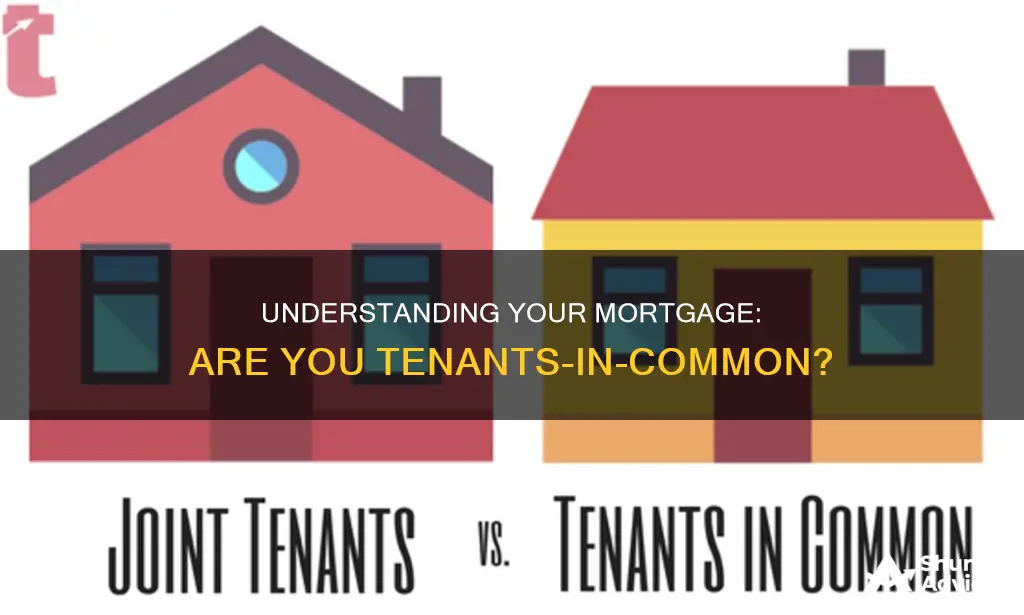
Tenants-in-common (TIC) is a type of ownership where two or more parties share an interest in real estate or land. Unlike joint tenancy, where each party owns an equal share of the property, tenants-in-common allows each party to have a different ownership share. For example, two people could each own 25% of the property, and a third person could own the remaining 50%. Each person can pay a different portion of the mortgage based on their ownership percentage, and all tenants are responsible for the full payment of the loan. This type of ownership is common among unmarried parties or other individuals who jointly acquire property.
| Characteristics | Values |
|---|---|
| Number of people involved | Two or more people or corporations |
| Ownership share | Equal or unequal |
| Mortgage payment | Each person can pay a different portion based on their ownership percentage |
| Agreement | All parties must be listed on the property title and sign the mortgage |
| Right of survivorship | No |
| Sale of share | Each party is free to sell their share of the property |
| Credit score impact | Yes |
| Deed of Trust | Required |
| Will | Required |
What You'll Learn

Tenants-in-common vs joint tenancy
When considering purchasing a property with someone else, it is important to understand the differences between a joint tenancy and a tenants-in-common agreement. Both options allow for co-ownership of a property, but there are some key differences to be aware of.
Joint Tenancy
In a joint tenancy, all tenants must obtain equal shares of the property, usually with the same deed, at the same time. This type of ownership comes with rights of survivorship, meaning that if one owner dies, their share of the property automatically passes to the surviving owners. Joint tenancy is commonly used for married couples or family members, as it ensures that the property passes to the surviving owner(s) without the need for probate. However, it is important to note that if one of the tenants owes a debt, a creditor has the power to terminate a joint tenancy, even if the other co-owners are not involved in that debt. Additionally, if one owner wants to buy out the other, the property must be sold, and the proceeds distributed equally.
Tenants-in-Common
A tenants-in-common agreement allows for multiple owners to own different percentages of the property. For example, one tenant could own 25% while the other owns 75%. This type of ownership does not carry rights of survivorship, so if one tenant dies, their share does not automatically pass to the other tenants but is instead passed on to their heirs. Each tenant in a tenants-in-common agreement has the right to sell their share of the property without the consent of the other tenants. However, it is important to note that tenants-in-common agreements can be more complex and may require additional legal documentation, such as a Deed of Trust.
In summary, the main differences between joint tenancy and tenants-in-common agreements lie in the equal vs. unequal ownership percentages, the rights of survivorship, and the ability to sell shares of the property. When deciding between these options, it is important to carefully consider your goals, preferences, and unique circumstances, and to consult with a legal or real estate professional.
Finding Mortgage Records: A Comprehensive Guide
You may want to see also

The process of applying for a tenants-in-common mortgage
A tenants-in-common mortgage is a type of shared ownership mortgage where two or more people (or corporations) take out a loan together to co-own a property. Unlike joint tenancy, where each party owns an equal share of the property, tenancy-in-common allows each party to have a different ownership share. For example, in a tenancy-in-common agreement, two people could each own 25% of the property, and a third person could own the remaining 50%. Similarly, each person can pay a different proportion of the mortgage based on their ownership percentage.
Before applying for a tenants-in-common mortgage, it is advisable to work out an agreement in advance and put it in writing so that everyone is aware of their monetary responsibilities. It is recommended to seek professional advice and have a lawyer draw up contracts to ensure the agreement is legally binding. Each member of a tenants-in-common agreement can decide to leave the agreement by forcing a sale of their share in the property. It is important to note that there is no right of survivorship with this type of agreement, meaning that if one member dies, their ownership rights do not automatically go to the other owners but pass to their estate.
Understanding Your Mortgage Grace Period: What You Need to Know
You may want to see also

The benefits of a tenants-in-common mortgage
A tenants-in-common mortgage is when two or more people (or corporations) take out a loan together to buy a property as co-owners. Here are some benefits of this type of mortgage:
Flexibility
Tenants-in-common mortgages offer flexibility in ownership shares. Co-owners can hold unequal shares, allowing each party to invest according to their financial capabilities and goals. For example, one owner can hold 30% while another holds 70%. This flexibility also extends to the ability to sell, mortgage, or gift their share without needing permission from other co-owners.
Estate Planning Advantages
This type of mortgage allows each tenant control over their share. In the case of death, the tenant can bequeath their share of the property to a named beneficiary, and their share will pass to their estate (and thus their heirs). This is in contrast to joint tenancy, where the ownership portion passes to the surviving owner.
Affordability
With rising property prices, a tenants-in-common mortgage can make it more affordable to buy a home by sharing the cost with non-family members or those not romantically linked. Ownership shares can be determined by what each person can contribute to the down payment and monthly mortgage payments.
Tax Benefits
In most tax jurisdictions, tenants-in-common will receive a single property tax bill. Tenants can deduct payments from their income tax filings and may be able to deduct a percentage of the total tax based on their level of ownership.
It is important to note that while a tenants-in-common mortgage offers these benefits, there are also potential drawbacks and complexities, such as disputes among co-owners and challenges in obtaining financing due to the shared ownership structure. It is crucial to have a thorough understanding of this arrangement and seek professional advice before entering into any legal agreements.
Keep Your Mortgage Steady: Tips to Avoid Rising Costs
You may want to see also

The disadvantages of a tenants-in-common mortgage
Tenants-in-common (TIC) is a co-ownership arrangement in real estate where two or more individuals hold ownership interests. While it offers several benefits, such as flexible ownership and estate planning advantages, there are also some disadvantages to consider. Here are some of the key disadvantages of a tenants-in-common mortgage:
No Right of Survivorship
One of the significant disadvantages of tenants-in-common ownership is the absence of survivorship rights. In this type of arrangement, if one owner passes away, their share of the property does not automatically pass to the surviving owners. Instead, it is passed on to the deceased owner's heirs or beneficiaries, as stated in their will. This can lead to complications, especially if the remaining tenants do not get along with the new owner or have different ideas about the property's management.
Potential for Disagreements and Conflicts
Tenants-in-common ownership can lead to disagreements and conflicts among co-owners. For example, one owner may want to sell their share, while others may prefer to retain ownership. Additionally, co-owners could disagree on property management, maintenance costs, or sales terms. These disputes can be challenging to resolve and may require legal intervention.
Combined Financial Responsibility and Liability
In a tenants-in-common arrangement, all co-owners are jointly responsible for mortgage payments and property taxes. If one tenant defaults on their mortgage payments or fails to pay their share, the other tenants are responsible for making up the difference. This combined financial responsibility can be a disadvantage, especially if there are discrepancies in financial capabilities or if one tenant is unreliable in making their payments.
Probate Process and Expenses
When a tenant-in-common passes away, their share of the property becomes part of their estate and may need to go through the probate process. Probate court can be expensive and time-consuming, adding an extra layer of complexity and cost to the estate administration.
Unfamiliar Co-Owners
In a tenants-in-common agreement, an owner can sell their share to someone else without the consent of the other co-owners. This means that a previously unknown co-owner may be introduced to the other tenants, and the remaining tenants may end up owning the property with someone they do not know or with whom they do not agree.
Partition Action and Forced Sale
Disagreements among co-owners can lead to a partition action, where a court may order the property to be physically divided or sold, even if some tenants do not want to sell their share. This can be a disadvantage if the tenants have differing goals and preferences regarding the property.
Understanding Balloon Mortgages: Do You Have One?
You may want to see also

The legal requirements of a tenants-in-common mortgage
A tenants-in-common mortgage is a legal arrangement where two or more parties have ownership interests in a real estate property or a parcel of land. Each tenant can own a different percentage of the property, and there is no right of survivorship, meaning that if one tenant dies, their share of the property goes to their beneficiaries or heirs rather than to the other owners.
Property Description
The agreement must include a detailed description of the property, including its legal description as per county records. This should include the lot number, block number, and any other identifiers to avoid ambiguity.
Ownership Shares
The specific percentages of ownership for each tenant must be specified in the agreement. This allocation can reflect the amount each party invested in the property or other considerations. Clearly defined shares help prevent disputes and clarify each tenant's stake in the property.
Voting Power and Decision-Making
The agreement should outline the decision-making process and the voting power of each tenant.
Financial Obligations
The agreement must detail the financial obligations of each tenant, including their share of expenses such as mortgage payments, property taxes, maintenance costs, and repairs. It should also address income distribution, including the proportion of rental income or sale proceeds.
Transfer of Ownership
The procedures for transferring ownership interests should be outlined in the agreement. This includes conditions under which a tenant can sell their share, gifting shares to family members or others, and provisions for transferring shares through a will.
Dispute Resolution
The agreement should specify mechanisms for resolving conflicts, such as mediation, arbitration, or court proceedings, in case disputes arise among the tenants.
It is important to note that each state has its own laws governing tenants-in-common agreements, so it is essential to ensure the agreement complies with the relevant state statutes and regulations to avoid legal issues. While not mandatory, recording the agreement with the county recorder's office can provide public notice of each tenant's ownership interest and protect against future claims.
Understanding Your Mortgage: Am I Eligible?
You may want to see also
Frequently asked questions
A tenants-in-common mortgage is when two or more people (or corporations) take out a loan together to buy a property as co-owners.
In a joint tenancy, both parties own an equal share of the property and if one person dies, their share of the property automatically passes to the other owner. In a tenants-in-common mortgage, the shares can be split on an unequal basis and each owner can bequeath their share of the property to whoever they wish.
A tenants-in-common mortgage can be a good option for non-family members or those not romantically linked who want to share the cost of buying a house. It also allows flexible ownership of shares.
One obvious downside is the chance that one tenant will want to sell the property, which can make it difficult for the other owners. Another downside is that if one tenant defaults on mortgage payments, the other tenants are responsible for making up the difference.
You can apply for a joint mortgage directly to lending institutions, via a mortgage broker or by using a comparison website. You will then need to use a solicitor to draw up a Deed of Trust specifying share ownership and the tenants-in-common arrangement.







